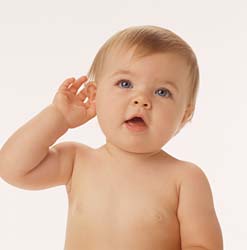Auditory Screening
INDIETROAuditory Screening

 There are inventions that can change people's lives significantly and create new conditions which, until not too long ago, were unimaginable. For example, the miracle of "creating" hearing for thousands of infants born deaf - through a process of diagnosis, surgery, and rehabilitation - is now very well-established and can offer extraordinary results.
There are inventions that can change people's lives significantly and create new conditions which, until not too long ago, were unimaginable. For example, the miracle of "creating" hearing for thousands of infants born deaf - through a process of diagnosis, surgery, and rehabilitation - is now very well-established and can offer extraordinary results.
The first phase, or rather, the diagnosis of congenital deafness (or even more accurately, profound sensorineural hearing loss), entails universal screening through a hearing test carried out within the first few weeks of the infant's life.
Why is auditory screening so important?
Because functional deafness can be prevented. Every year, between 500 and 1,000 infants with profound sensory deafness are born in Italy. Today it is possible to perform a hearing test on newborns as young as two days old, through a simple and very reliable procedure using Otoaucoustic Emissions (OAE). The test is carried out while the infant is sleeping naturally by inserting a small, flexible, rubber probe into in the ear canal (Bubbico, 2004).
The probe emits an acoustic signal and a device analyzes the acoustic reverberation on the eardrum allowing it to identify potential sensory hearing impairments with a high level of accuracy. If the results should be negative, the test is repeated before proceeding on to more in-depth methods such as auditory evoked potentials. The test is specific, reliable, and painless.
How does the Foundation contribute?
The Ginevra Caltagirone Foundation decided to contribute to the diffusion of this important test, by donating an Otoport Screener to the Fatebenefratelli Hospital in Rome. The equipment was delivered to the Neonatology ward in June 2011 and has been in use since July 2011

